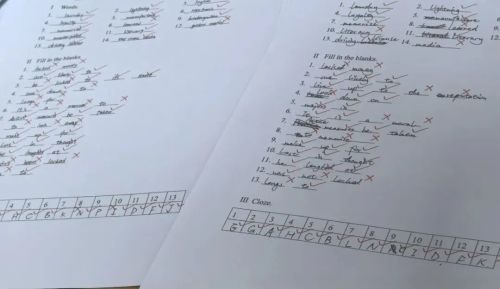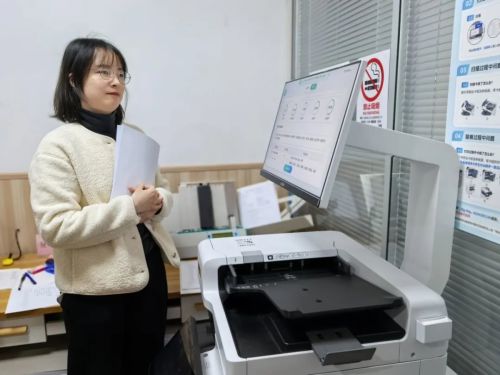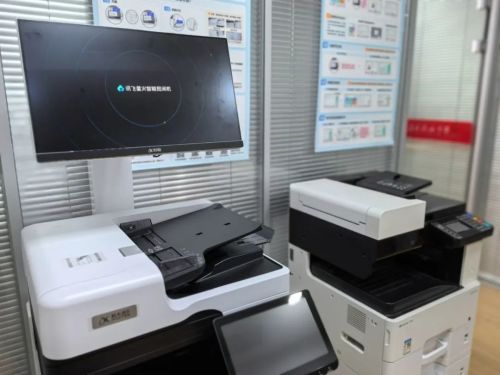Over 110 Shanghai Schools Use AI to Grade Homework
Students: First Time in Six Years of School Fully Participating in Classroom Interaction
**Author: IT Times Reporter Sun Yan**
**Editor: Pan Shaoying**

“The new semester’s formula is diligence plus laughter equals a perfect score. If the equation doesn’t balance, don’t ask me. Come on, Professor Xu, let’s go get a coffee!” On the lawn of Shanghai Gezhi Middle School, statues of the school’s two founders—Chinese modern chemist Xu Shou and Englishman John Fryer—have “come alive,” manipulated by a sophomore boy using AI technology. He wrote scripts with DeepSeek, animated static photos with Jiemeng AI, and generated character voiceovers with iFlytek Spark large language model. Today, high school students’ ability to use AI may already exceed that of many professionals.
“For a class dictation test, it used to take me a full 40-minute period to grade by myself. Now with the grading machine, I can devote that time to improving teaching quality, greatly freeing myself from homework correction,” says Li Weiyan, an English teacher at Shanghai Yan’an Middle School, as she retrieves marked dictation papers from the Spark intelligent grading machine.
“Can colors make the butterfly nice?” Chen Dan, an English teacher at Longning District’s Shicun Elementary School, carefully designed this question using a large language model to better engage her students. From classroom to extracurricular activities, AI is becoming an indispensable assistant for teachers.
In Shanghai, an AI-driven education revolution is taking place. AI not only inspires students’ abilities, bringing the campus grass, trees, sculptures, and murals “to life,” but also liberates teachers from complex, repetitive grading work, making classrooms more engaging.

Grading Machines Reduce 80% of Teachers’ Repetitive Work
Walking into the printing room of Shanghai Yan’an Middle School, English teacher Li Weiyan is operating a Spark intelligent grading machine to mark dictation papers. The machine completes in just over ten minutes what would have taken 40 minutes of manual grading.
This machine looks like a regular printer with an additional touch screen. It only takes three steps to complete paper grading, making it easy even for first-time users. First, scan the answer sheet and select the class being scanned; second, scan student papers, with a class of about 40 students completed in 3 minutes, after which the machine automatically completes the grading; third, print with annotations, confirming the class and enabling annotated printing, arranging papers neatly to avoid paper jams, and activating annotation with one click.
Li Weiyan takes out a stack of dictation papers with red correction marks from the grading machine and carefully checks whether the corrections are accurate. “The grading machine is very precise, recognizing different students’ handwriting and reducing scoring errors caused by manual mistakes,” she tells the IT Times reporter. She demonstrates the data report on the grading machine, clearly showing excellent rates, pass rates, and other statistics without needing manual tallying. It also outputs common problems, difficult points, and error-prone points, helping teachers understand which vocabulary students haven’t mastered yet and allowing timely adjustment of teaching strategies.
“The Spark intelligent grading machine not only liberates teachers from heavy homework correction but also improves classroom efficiency because teachers can quickly grasp which questions need to be emphasized in class. In the future, we hope the grading machine can correct more types of questions and provide more guidance to students, helping them learn knowledge faster and better,” Li Weiyan says.

**According to actual application data, the Spark intelligent grading machine has reduced teachers’ time spent on repetitive homework correction by 80%, while time devoted to school-based teaching research and targeted student guidance has increased by 100%.**
Large Model Grading Machines Become More “Versatile”
**Currently, iFlytek Spark intelligent grading machines have been implemented in more than 110 Shanghai schools, including Gezhi Junior High School, Shanghai Changqiao Middle School, Shanghai Minhang District Experimental Western School, and others, covering schools in Xuhui, Yangpu, Huangpu, Jing’an, and other districts.**
Taking Changning District as an example, in November 2024, Spark intelligent grading machines were introduced to all high schools in the district. Four months later, mathematics and English subjects across seven grades, from sixth grade to senior year, have basically achieved regular application of Spark intelligent grading machines, scanning nearly 100,000 student assignments.
Machine grading has already been widely used in large-scale examinations such as college and high school entrance exams, but grading machines equipped with large models have become more versatile.
From the feedback of English and mathematics teachers, the grading machine’s accuracy for objective questions is very high, precisely recognizing even the most untidy handwriting, papers with drafts, and erasures. For English, the grading machine can now handle more than just dictation and multiple-choice questions; it can also grade translations, essays, and other question types. Looking at the annotations on an essay, the grading machine can provide accurate scoring, comment on each sentence, offer polishing suggestions, highlight good words and phrases, and even write teacher comments and improvement suggestions at the end—sometimes even more thorough than manual teacher grading.
Teachers Better at Questioning, Students More Willing to Participate
“Can colors make the butterfly nice?” Chen Dan used AI to make her classroom more vibrant. Upon hearing this question, students spontaneously called out words like “red,” “blue,” “colors,” and so on, unaware that this was a carefully designed question using AI.
During Chen Dan’s lessons, a large model called “AI Classroom Record Analysis” records the teacher-student dialogues in real time. Through AI-generated reports, Chen Dan discovered an issue: “In the first class, I asked ‘Nice Why,’ and found that the children didn’t understand this question very well, so I changed it to ‘Can colors make the butterfly nice,’ and the frequency of interaction with students increased.”
With AI as an assistant, teachers at Shicun Elementary School have transformed every lesson into an open class, improving their teaching based on data analysis and feedback after class. When teachers become better at asking questions, students become more active in classroom interaction.
“How do you design an aesthetically pleasing umbrella stand to fit 40 umbrellas that are 70 centimeters long?” In a sixth-grade mathematics class at Qiuzhen Middle School, math teacher Li Ying transformed a traditional cylinder analysis lesson into an interesting real-life problem. Faced with the teacher’s question, each student began dialoguing with an AI assistant on their tablet, seeking help from this AI teaching assistant.
**In a 40-minute class, a teacher can’t call on one student per minute to answer questions. With the AI assistant, teachers can communicate with each student, activating the entire classroom. Some students have reported that this AI teaching method has allowed them to fully participate in classroom interactions for the first time in six years of schooling.**
Over several months, teachers and students at Qiuzhen Middle School have “fed” knowledge graphs to the AI assistant for each subject, making it a personal tutor for each student. Through interactions between the AI assistant and students, it forms a unique digital portrait of each student, achieving truly personalized classrooms.
Since the emergence of large models, from teachers to students, from adults to children, almost everyone has experienced technological anxiety, wondering how to avoid being replaced by AI. On this quest, Shanghai’s education sector has taken the lead in experimenting, putting AI to use, empowering teachers with AI, and using AI to stimulate students’ abilities.
IT Times has previously reported on how several Shanghai universities have been “transformed” by AI. In Shanghai University of Engineering Science classrooms, students attentively “wander off” on their phones while scrolling danmu (bullet comments) on the large screen at the front of the classroom, expressing real-time thoughts about the teacher’s content. At ShanghaiTech University, each classroom has been transformed into a smart pad or phone, displaying teaching resources like course materials, videos, and experiments. Meanwhile, AI digital humans are being incubated that will conduct lessons based on teachers’ materials.
AI Education Contributes to the Growing Online Education Market
Now, AI is penetrating Shanghai’s primary and secondary schools, with artificial intelligence general education spreading to schools nationwide, truly starting from the youngest students. Early this year, the Shanghai Municipal Education Commission issued the “Notice on Carrying Out Artificial Intelligence Education Experimental School Pilot Work,” designating 89 primary and secondary schools (including kindergartens and secondary vocational schools) as Shanghai’s artificial intelligence education experimental schools. These include Shanghai Yan’an Middle School, Shanghai High School, Fudan University Affiliated Middle School, Qibao Middle School, Jianping Middle School, Datong Middle School, Shanghai Experimental Primary School, Xuhui District Science and Technology Kindergarten, Shanghai Information Management School, and others.
According to iiMedia Research data, China’s online education market reached 262.8 billion yuan in 2023, with artificial intelligence contributing about 7%. By 2027, artificial intelligence’s contribution to the online education market is expected to climb to about 16%.
“What exactly is the use of large models?” Practical application is the mandatory question for large models in 2025, and AI transformation is the mandatory question for every school in 2025.
Layout: Ji Jiaying
Images: IT Times
Source: “IT Times” WeChat public account vittimes